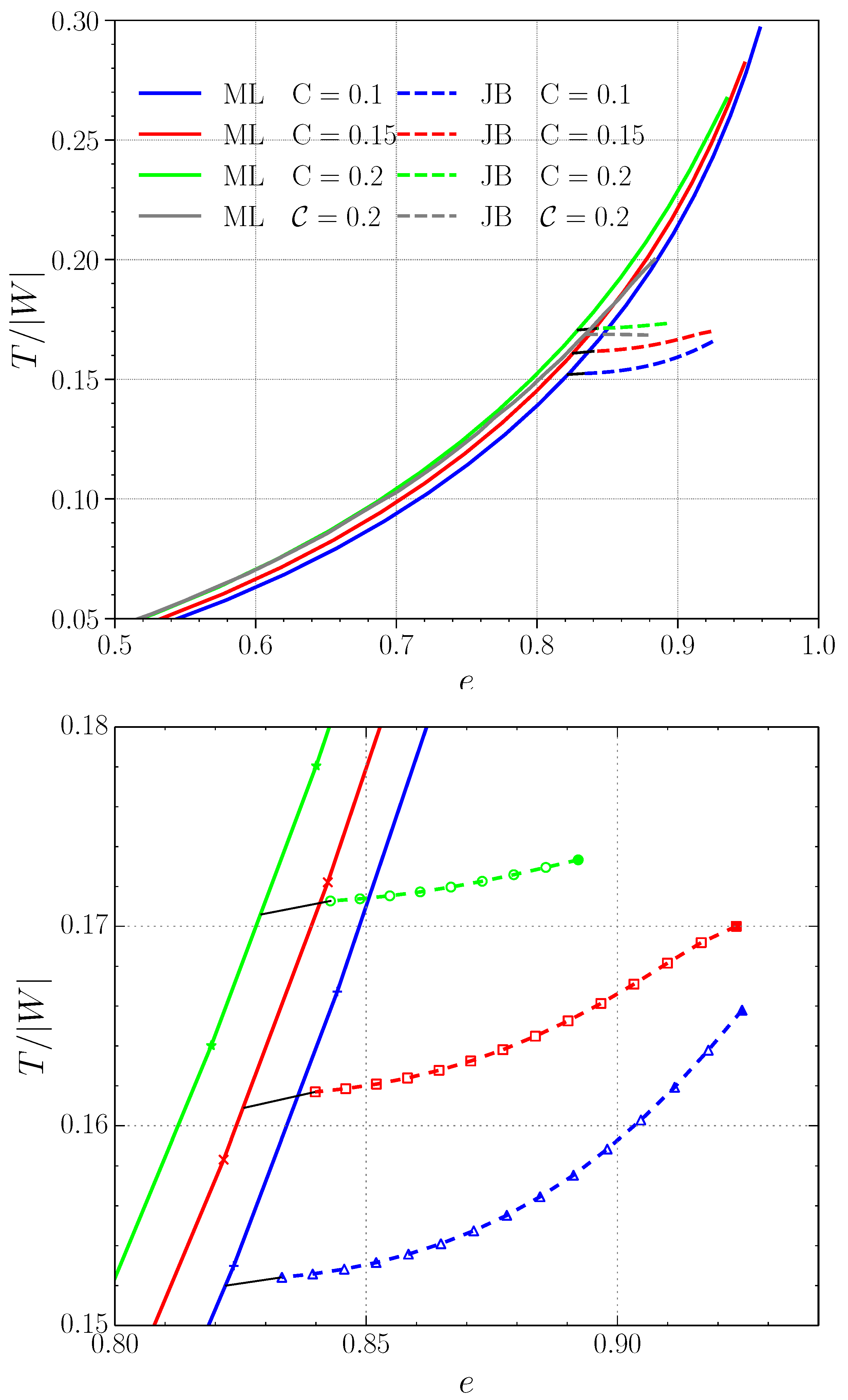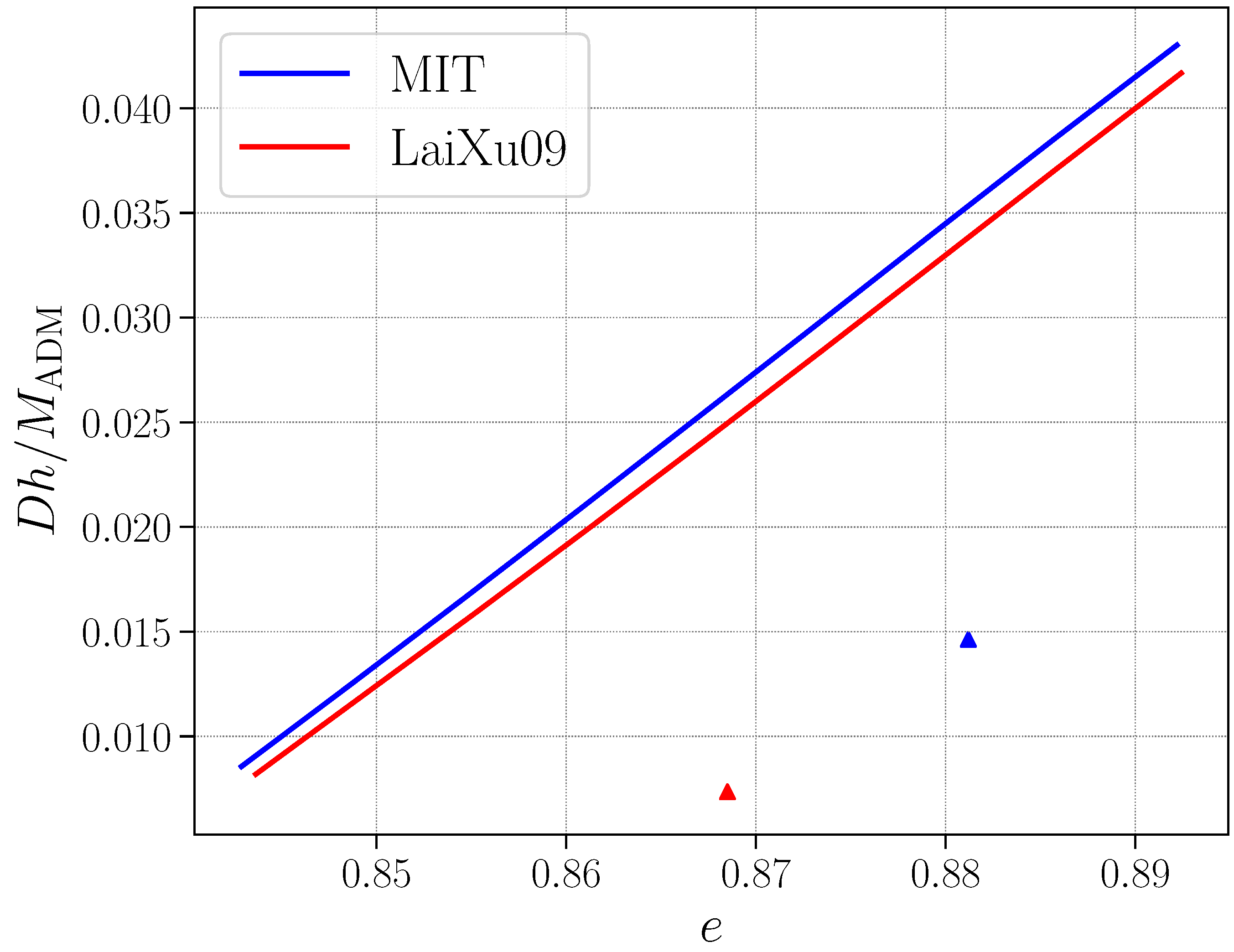Rotating Quark Stars in General Relativity
Abstract
:1. Introduction
2. Results
2.1. Maximum Mass of Axisymmetric Rotating Quark Stars
2.2. Triaxial Rotating Quark Stars
3. Discussion
Acknowledgments
Author Contributions
Conflicts of Interest
References
- Abbott, B.P.; Abbott, R.; Acernese, F.; Ackley, F.; Adams, C.; Adamsa, T.; Addesso, P.; Adhikari, R.X.; Adya, V.B.; et al. GW170817: Observation of Gravitational Waves from a Binary Neutron Star Inspiral. Phys. Rev. Lett. 2017, 119, 161101. [Google Scholar] [CrossRef] [PubMed]
- Abbott, B.P.; Abbott, R.; Acernese, F.; Ackley, F.; Adams, C.; Adamsa, T.; Addesso, P.; Adhikari, R.X.; Adya, V.B.; et al. Multi-messenger Observations of a Binary Neutron Star Merger. Astrophys. J. Lett. 2017, 848, L12. [Google Scholar] [CrossRef]
- Abbott, B.P.; Abbott, R.; Acernese, F.; Ackley, F.; Adams, C.; Adamsa, T.; Addesso, P.; Adhikari, R.X.; Adya, V.B.; et al. Gravitational Waves and Gamma-Rays from a Binary Neutron Star Merger: GW170817 and GRB 170817A. Astrophys. J. Lett. 2017, 848, L13. [Google Scholar] [CrossRef]
- Abbott, B.P.; Abbott, R.; Acernese, F.; Ackley, F.; Adams, C.; Adamsa, T.; Addesso, P.; Adhikari, R.X.; Adya, V.B.; et al. Estimating the Contribution of Dynamical Ejecta in the Kilonova Associated with GW170817. Astrophys. J. Lett. 2017, 850, L39. [Google Scholar] [CrossRef]
- Baiotti, L.; Rezzolla, L. Binary neutron-star mergers: A review of Einstein’s richest laboratory. Rep. Prog. Phys. 2017, 80, 096901. [Google Scholar] [CrossRef] [PubMed]
- Andersson, N.; Ferrari, V.; Jones, D.I.; Kokkotas, K.D.; Krishnan, B.; Read, J.S.; Rezzolla, L.; Zink, B. Gravitational waves from neutron stars: Promises and challenges. Gen. Relativ. Gravit. 2011, 43, 409–436. [Google Scholar] [CrossRef]
- Abramovici, A.A.; Althouse, W.; Drever, R.P.; Gursel, Y.; Kawamura, S.; Raab, F.; Shoemaker, D.; Sievers, L.; Spero, R.; Thorne, K.S.; et al. LIGO: The Laser Interferometer Gravitational-Wave Observatory. Science 1992, 256, 325–333. [Google Scholar] [CrossRef] [PubMed]
- Punturo, M.; Abernathy, M.; Acernese, F.; Allen, B.; Andersson, N.; Arun, K.; Barone, F.; Barr, B.; Barsuglia, M.; Beker, M.; et al. The third generation of gravitational wave observatories and their science reach. Class. Quantum Gravity 2010, 27, 084007. [Google Scholar] [CrossRef]
- Accadia, T.; Acernese, F.; Antonucci, F.; Astone, P.; Gallardin, G.; Barone, F.; Barsuglia, M.; Basti, A.; Bauer, T.S.; Bebronne, M.; et al. Status of the Virgo project. Class. Quantum Gravity 2011, 28, 114002. [Google Scholar] [CrossRef] [Green Version]
- Kuroda, K. Status of LCGT. Class. Quantum Gravity 2010, 27, 084004. [Google Scholar] [CrossRef]
- Aso, Y.; Michimura, Y.; Somiya, K.; Ando, M.; Miyakawa, O.; Sekiguchi, T.; Tatsumi, D.; Yamamoto, H. Interferometer design of the KAGRA gravitational wave detector. Phys. Rev. D 2013, 88, 043007. [Google Scholar] [CrossRef]
- Chandrasekhar, S. Ellipsoidal Figures of Equilibrium; Yale Univ. Press: New Haven, CT, USA, 1969. [Google Scholar]
- Meinel, R.; Ansorg, M.; Kleinwächter, A.; Neugebauer, G.; Petroff, D. Relativistic Figures of Equilibrium; Cambridge University Press: Cambridge, UK, 2008. [Google Scholar]
- Friedman, J.L.; Stergioulas, N. Rotating Relativistic Stars; Cambridge University Press: Cambridge, UK, 2013. [Google Scholar]
- Breu, C.; Rezzolla, L. Maximum mass, moment of inertia and compactness of relativistic stars. Mon. Not. R. Astron. Soc. 2016, 459, 646–656. [Google Scholar] [CrossRef]
- Weih, L.R.; Most, E.R.; Rezzolla, L. On the stability and maximum mass of differentially rotating relativistic stars. Mon. Not. R. Astron. Soc. 2017, 473, L126–L130. [Google Scholar] [CrossRef]
- Bozzola, G.; Stergioulas, N.; Bauswein, A. Universal relations for differentially rotating relativistic stars at the threshold to collapse. Mon. Not. R. Astron. Soc. 2017, 474, 3557–3564. [Google Scholar] [CrossRef]
- Yagi, K.; Yunes, N. I-Love-Q. Science 2013, 341, 365. [Google Scholar] [CrossRef] [PubMed]
- Yagi, K.; Yunes, N. I-Love-Q relations in neutron stars and their applications to astrophysics, gravitational waves, and fundamental physics. Phys. Rev. D 2013, 88, 023009. [Google Scholar] [CrossRef]
- Yagi, K.; Yunes, N. Approximate universal relations for neutron stars and quark stars. Phys. Rep. 2017, 681, 1–72. [Google Scholar] [CrossRef]
- Huang, X.; Markakis, C.; Sugiyama, N.; Uryū, K. Quasi-equilibrium models for triaxially deformed rotating compact stars. Phys. Rev. D 2008, 78, 124023. [Google Scholar] [CrossRef]
- Uryū, K.; Tsokaros, A.; Galeazzi, F.; Hotta, H.; Sugimura, M.; Taniguchi, K.; Yoshida, S. New code for equilibriums and quasiequilibrium initial data of compact objects. III. Axisymmetric and triaxial rotating stars. Phys. Rev. D 2016, 93, 044056. [Google Scholar] [CrossRef]
- Itoh, N. Hydrostatic Equilibrium of Hypothetical Quark Stars. Prog. Theor. Phys. 1970, 44, 291–292. [Google Scholar] [CrossRef]
- Alcock, C.; Farhi, E.; Olinto, A. Strange stars. Astrophys. J. 1986, 310, 261–272. [Google Scholar] [CrossRef]
- Bodmer, A.R. Collapsed Nuclei. Phys. Rev. D 1971, 4, 1601–1606. [Google Scholar] [CrossRef]
- Witten, E. Cosmic separation of phases. Phys. Rev. D 1984, 30, 272–285. [Google Scholar] [CrossRef]
- Lai, X.Y.; Yu, Y.W.; Zhou, E.P.; Li, Y.Y.; Xu, R.X. Merging Strangeon Stars. Res. Astron. Astrophys. 2018, 18, 024. [Google Scholar] [CrossRef]
- Li, A.; Zhang, B.; Zhang, N.B.; Gao, H.; Qi, B.; Liu, T. Internal x-ray plateau in short GRBs: Signature of supramassive fast-rotating quark stars? Phys. Rev. D 2016, 94, 083010. [Google Scholar] [CrossRef]
- Uryū, K.; Tsokaros, A. New code for equilibriums and quasiequilibrium initial data of compact objects. Phys. Rev. D 2012, 85, 064014. [Google Scholar] [CrossRef]
- Uryū, K.; Tsokaros, A.; Grandclement, P. New code for equilibriums and quasiequilibrium initial data of compact objects. II. Convergence tests and comparisons of binary black hole initial data. Phys. Rev. D 2012, 86, 104001. [Google Scholar] [CrossRef]
- Tsokaros, A.; Uryū, K. Binary black hole circular orbits computed with cocal. J. Eng. Math. 2012, 82, 133–141. [Google Scholar] [CrossRef]
- Tsokaros, A.; Uryū, K.; Rezzolla, L. New code for quasiequilibrium initial data of binary neutron stars: Corotating, irrotational, and slowly spinning systems. Phys. Rev. D 2015, 91, 104030. [Google Scholar] [CrossRef]
- Rezzolla, L.; Most, E.R.; Weih, L.R. Using Gravitational-wave Observations and Quasi-universal Relations to Constrain the Maximum Mass of Neutron Stars. Astrophys. J. Lett. 2018, 852, L25. [Google Scholar] [CrossRef]
- Lai, X.Y.; Xu, R.X. Strangeon and Strangeon Star. J. Phys. Conf. Ser. 2017, 861, 012027. [Google Scholar] [CrossRef]
- Lai, D.; Shapiro, S.L. Gravitational radiation from rapidly rotating nascent neutron stars. Astrophys. J. 1995, 442, 259–272. [Google Scholar] [CrossRef]
- Bildsten, L. Gravitational Radiation and Rotation of Accreting Neutron Stars. Astrophys. J. Lett. 1998, 501, L89–L93. [Google Scholar] [CrossRef]
- Woosley, S.; Janka, T. The physics of core-collapse supernovae. Nat. Phys. 2005, 1, 147–154. [Google Scholar] [CrossRef]
- Watts, A.L.; Krishnan, B.; Bildsten, L.; Schutz, B.F. Detecting gravitational wave emission from the known accreting neutron stars. Mon. Not. R. Astron. Soc. 2008, 389, 839–868. [Google Scholar] [CrossRef]
- Piro, A.L.; Thrane, E. Gravitational Waves from Fallback Accretion onto Neutron Stars. Astrophys. J. 2012, 761, 63. [Google Scholar] [CrossRef]
- Tsokaros, A.; Ruiz, M.; Paschalidis, V.; Shapiro, S.L.; Baiotti, L.; Uryō, K. Gravitational wave content and stability of uniformly, rotating, triaxial neutron stars in general relativity. Phys. Rev. D 2017, 95, 124057. [Google Scholar] [CrossRef]
- Gondek-Rosinska, D.; Haensel, P.; Zdunik, J.L.; Gourgoulhon, E. Rapidly rotating strange stars. In IAU Colloq. 177: Pulsar Astronomy-2000 and Beyond; Astronomical Society of the Pacific Conference Series; Kramer, M., Wex, N., Wielebinski, R., Eds.; Astronomical Society of the Pacific: San Francisco, CA, USA, 2000; Volume 202, p. 661. [Google Scholar]
- Gondek-Rosińska, D.; Bulik, T.; Zdunik, L.; Gourgoulhon, E.; Ray, S.; Dey, J.; Dey, M. Rapidly rotating compact strange stars. Astron. Astrophys. 2000, 363, 1005–1012. [Google Scholar]
- Gondek-Rosińska, D.; Stergioulas, N.; Bulik, T.; Kluźniak, W.; Gourgoulhon, E. Lower limits on the maximum orbital frequency around rotating strange stars. Astron. Astrophys. 2001, 380, 190–197. [Google Scholar] [CrossRef]
- Gondek-Rosińska, D.; Gourgoulhon, E.; Haensel, P. Are rotating strange quark stars good sources of gravitational waves? Astron. Astrophys. 2003, 412, 777–790. [Google Scholar] [CrossRef]
- Xu, R.X. Solid Quark Stars? Astrophys. J. Lett. 2003, 596, L59–L62. [Google Scholar] [CrossRef]




© 2018 by the authors. Licensee MDPI, Basel, Switzerland. This article is an open access article distributed under the terms and conditions of the Creative Commons Attribution (CC BY) license (http://creativecommons.org/licenses/by/4.0/).
Share and Cite
Zhou, E.; Tsokaros, A.; Rezzolla, L.; Xu, R.; Uryū, K. Rotating Quark Stars in General Relativity. Universe 2018, 4, 48. https://doi.org/10.3390/universe4030048
Zhou E, Tsokaros A, Rezzolla L, Xu R, Uryū K. Rotating Quark Stars in General Relativity. Universe. 2018; 4(3):48. https://doi.org/10.3390/universe4030048
Chicago/Turabian StyleZhou, Enping, Antonios Tsokaros, Luciano Rezzolla, Renxin Xu, and Kōji Uryū. 2018. "Rotating Quark Stars in General Relativity" Universe 4, no. 3: 48. https://doi.org/10.3390/universe4030048




